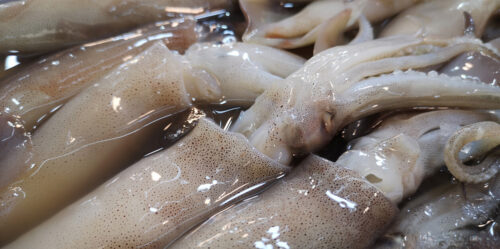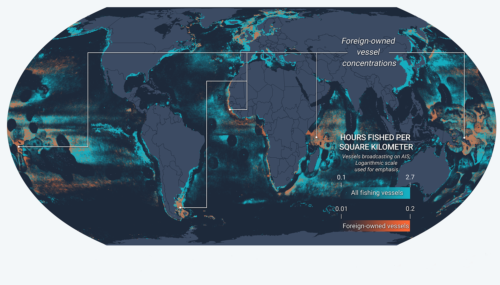Last Monday, we held a webinar in which 48 registered Global Fishing Watch users had an opportunity to hear from, and ask questions of, two of the authors of our recent report “The Global Footprint of Transshipment.”
The frequency and patterns of transshipment (when fishing vessels offload their catch onto refrigerated cargo ships for transport to shore) are not well understood, but the practice is illegal in many cases and widely associated with illegal fishing and other activity such as slave labor. Our report analyzed 21 billion AIS messages to identify and characterize patterns for 5,065 likely transshipments and 86,490 potential transshipments from 2012 through 2016.
For an example of the type of patterns we found, click on the image above that shows transshipment clusters around certain countries.
“We put out a pretty technical report with lots of figures and analysis that we want people to be able to use,” said David Kroodsma, our Research Program Director and lead author on the report, “but I think it’s really helpful to explain exactly what’s in it.” A webinar series seemed like a good way to do that, and the responses we received to this first event were promising. “I see the webinar as a tool to help others use our data and to help us improve Global Fishing Watch.”
Questions from participants covered a range of topics from fairly straightforward issues, such as whether or not we see vessels turning off their AIS, to more complex ones that highlight the need for more analysis. One participant asked if we can see relationships between individual refrigerated cargo vessels (reefers) and fishing vessels from certain companies or owners.
We’ve actually been asking similar questions, and the second author on our transshipment report, Data Scientist Nate Miller, was able to address the question. “So far, I haven’t really been able to identify any patterns around who is transshipping with who,” he said. “It seems to be more of an opportunistic thing where reefers and fishing vessels just seem to transship with whoever is nearby.” But that’s just a preliminary observation—there’s a lot more analysis to do—and the answer to that question is much more complex than it sounds, because vessel ownership is not reported in AIS data, meaning it must be manually traced back through registries.
For us, the webinar was valuable for learning about users with an immediate need we can address. One participant from South America has been observing reefers entering ports, and he is particularly interested in our plans to incorporate our reefer data into a new layer in the Global Fishing Watch Map later this year.
Another webinar participant working on fishing in Russia was interested in our data revealing that country’s significant contribution to global transshipment. (50 percent of likely transshipments occurred in Russian waters, and Russian-flagged vessels had the highest rate of potential transshipments per vessel than any other national fleet last year.)
“It’s rewarding to connect with people who are actually on the other end of our product,” said our Project Coordinator, Samantha Emmert. “They always provide valuable feedback. Hearing their questions during the seminar and just seeing their level of interest was really encouraging.” She says as long as users continue to show interest, and we can wrangle our scientists away from their data, she is willing to keep the dialogue going and making the webinars happen.
Our next webinar is coming up March 15. You can sign up here, and if you’re interested in attending a future webinar, contact Samantha.

